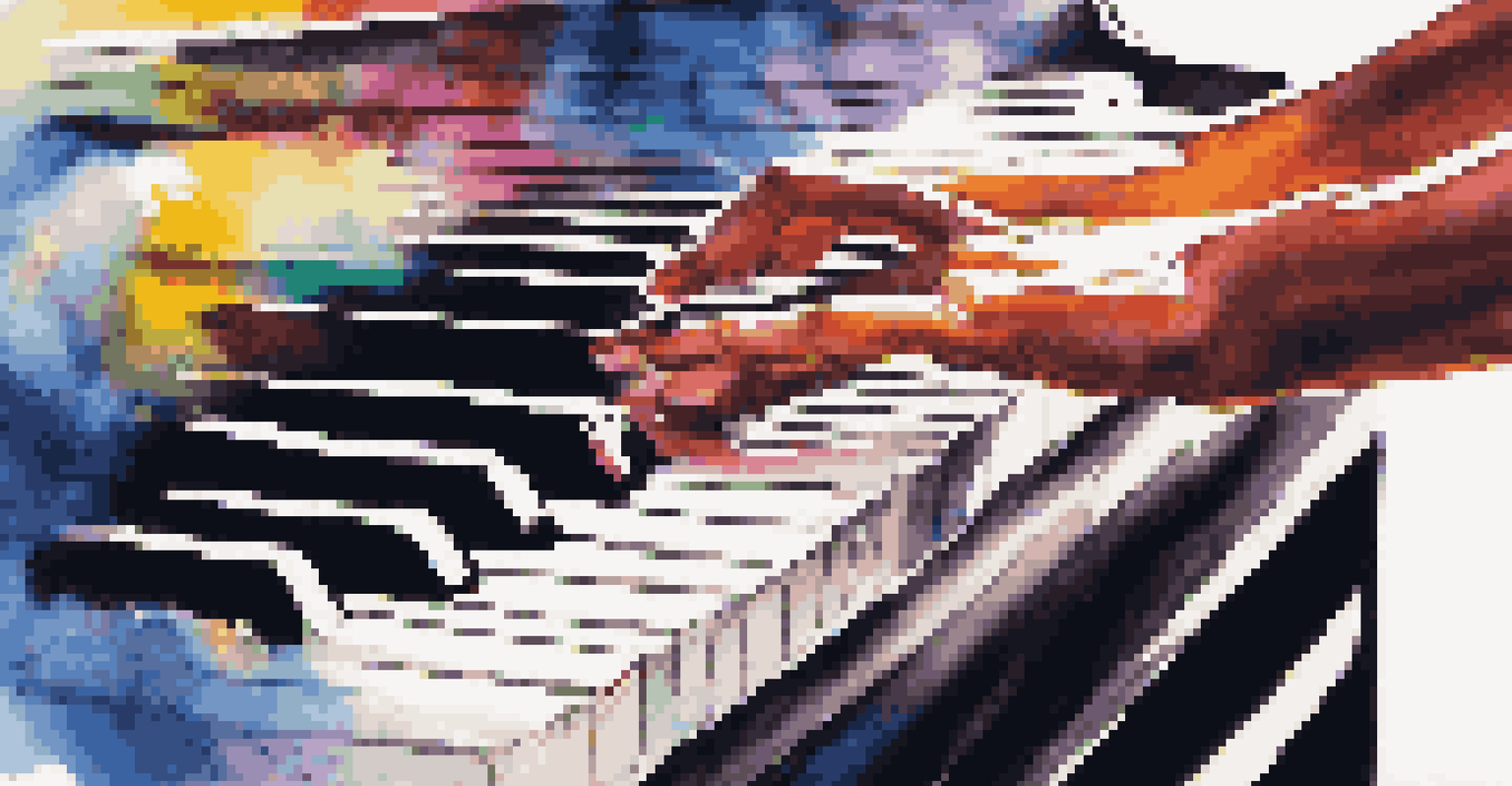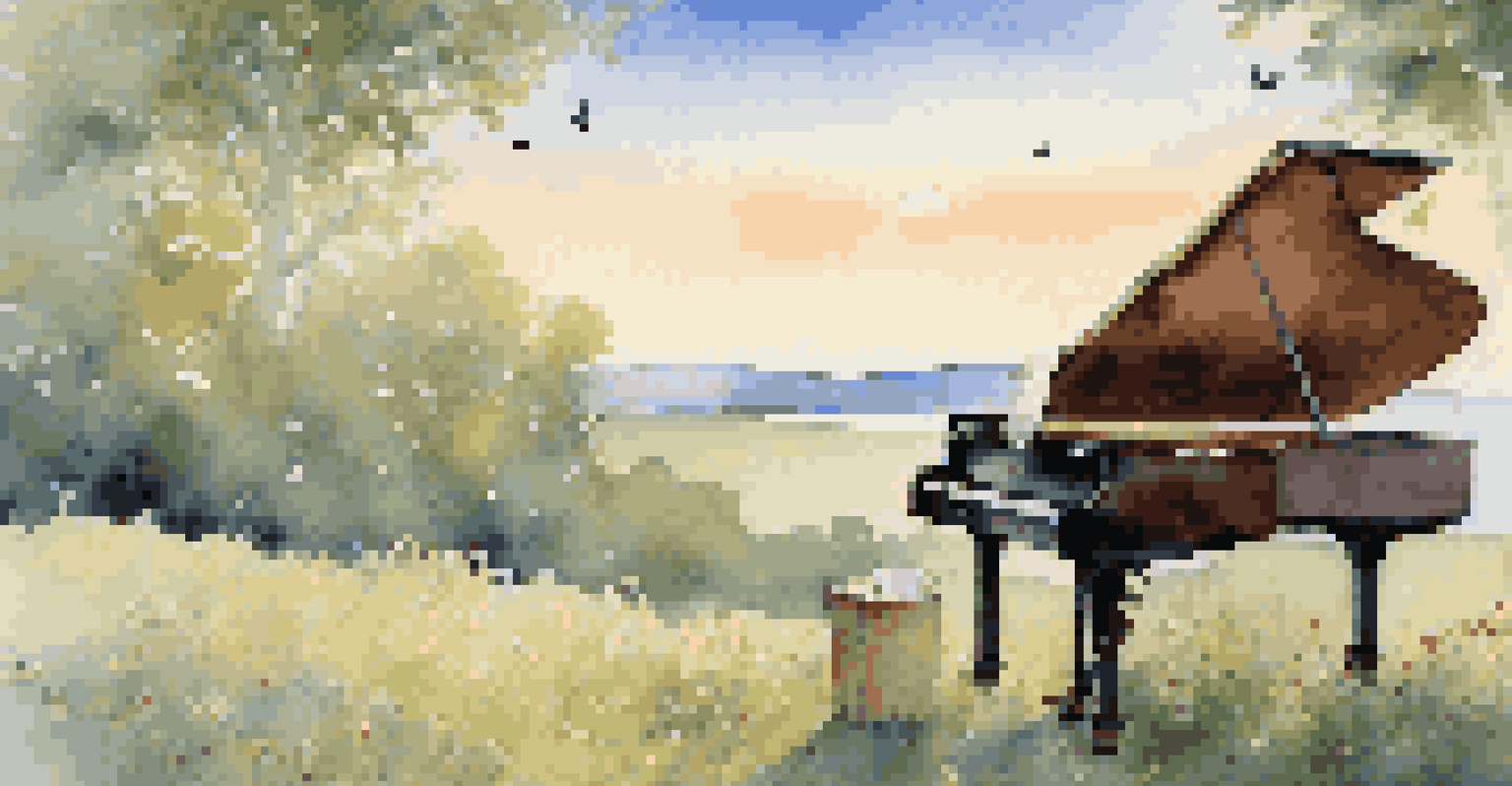Mastering the Art of Improvisation on Piano: Key Techniques

Understanding the Basics of Piano Improvisation
Improvisation on the piano is like a conversation with music. It allows you to express emotions and ideas spontaneously, without relying on written notes. To start, familiarize yourself with the piano's layout, focusing on scales and chords that form the foundation of most melodies.
The only way to make sense out of change is to plunge into it, move with it, and join the dance.
Think of improvisation as a playground for your creativity. You can explore different musical styles, from jazz to classical, and discover how various chords interact with each other. This exploration helps you understand the musical language, making it easier to speak through your instrument.
As you begin to improvise, remember that mistakes are part of the learning process. Embrace them as opportunities to discover new sounds and ideas. Over time, you’ll find your unique voice, blending technique and emotion into a captivating performance.
Key Techniques for Effective Improvisation
One of the most crucial techniques in piano improvisation is mastering scales. Scales are like the building blocks of music, and they provide a framework for creating melodies. Start with major and minor scales, and practice them until they feel comfortable under your fingers.

Another essential technique is the use of chords. Chords add depth and richness to your improvisation. Experiment with different chord progressions and try incorporating seventh and ninth chords for a more sophisticated sound. This will not only enhance your improvisation but also make it more enjoyable for your audience.
Embrace Mistakes in Improvisation
Mistakes are valuable learning opportunities that can lead to new sounds and personal growth in your musical journey.
Lastly, don't underestimate the power of dynamics and phrasing. Varying your volume and the way you articulate notes can significantly impact the emotional effect of your improvisation. Think of it as painting a picture; each stroke (or note) contributes to the overall feeling you want to convey.
Listening as a Tool for Improvement
Listening is a vital part of mastering piano improvisation. By actively listening to various genres and skilled musicians, you can absorb different improvisational styles and techniques. This not only broadens your musical vocabulary but also inspires your creativity.
Music is the shorthand of emotion.
For example, if you listen to jazz pianists, pay attention to their use of syncopation and swing. These elements add a unique flair to their improvisation, which you can incorporate into your own playing. Try to transcribe short solos and understand the thought process behind them.
Additionally, don't hesitate to record your improvisations and listen back. This practice helps identify areas for improvement and showcases your progress. It’s similar to watching a game tape in sports; it allows you to analyze your performance and refine your techniques.
Creating a Musical Vocabulary
Just like learning a new language, developing a musical vocabulary is essential for improvisation. This involves memorizing various scales, chords, and melodic patterns that you can draw upon during your performances. The more phrases you know, the more fluent you’ll become in expressing your musical ideas.
One way to build your vocabulary is through practice routines. Dedicate time each day to learn a new scale or chord progression, and incorporate it into your improvisation. Over time, these elements will become second nature, allowing you to focus more on expression rather than technical execution.
Build a Musical Vocabulary
Developing a rich musical vocabulary through scales and chords allows for greater expression and creativity in improvisation.
Additionally, consider improvising over backing tracks or with other musicians. This interactive practice will challenge you to think on your feet, helping you to apply your musical vocabulary in real-time. The dynamic exchange with other musicians can lead to exciting and unexpected musical moments.
The Role of Emotions in Improvisation
Improvisation isn't just about technical skills; it's also about connecting with emotions. When you sit at the piano, think about how you want to feel and what you want to convey through your music. This emotional connection can transform a simple melody into a powerful experience for both you and your listeners.
For instance, if you're feeling joyful, let that energy flow into your playing with bright, uplifting melodies. Conversely, if you’re experiencing sadness, explore deeper, melancholic tones. Your audience can often sense these emotions, making your performance more relatable and impactful.
Remember, vulnerability can be a strength in music. Allowing yourself to express genuine emotions can lead to improvisations that resonate deeply. The key is to trust your instincts and let your feelings guide your fingers across the keys.
Practicing Improvisation: Tips and Tricks
Practicing improvisation requires a balance of structure and freedom. Set aside dedicated practice time where you focus solely on improvising. Start with a simple chord progression and allow yourself to explore different melodies, rhythms, and dynamics without fear of making mistakes.
One effective tip is to impose limitations on your improvisation. For example, restrict yourself to using only a few notes or a specific scale. These constraints can spark creativity and lead to unexpected musical ideas that you might not have considered otherwise.
Connect Emotionally with Music
Improvisation is not just technical; connecting with your emotions can create a powerful experience for both you and your audience.
Lastly, make improvisation a fun and enjoyable part of your practice. Play along with your favorite songs or collaborate with fellow musicians. This social aspect can ignite your passion for improvisation and help you develop your skills in a supportive environment.
Finding Your Unique Musical Voice
Ultimately, mastering piano improvisation is about discovering your unique musical voice. Everyone has a different perspective and experiences that shape their playing style. Embrace your individuality and allow it to shine through in your improvisations.
To find your voice, experiment with various genres and techniques. You might find that you gravitate towards a particular style or blend multiple influences into something entirely new. This exploration is part of the journey, and it can lead to exciting, original compositions.

As you continue to grow as an improviser, remember that your voice will evolve over time. Stay open to new experiences and influences, and don’t be afraid to take risks. The more you explore, the more you'll discover the endless possibilities of piano improvisation.